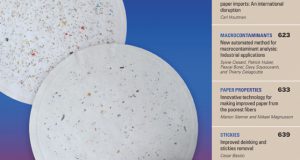
The papers summarized here are from the January 2017 issue of TAPPI Journal. TAPPI Journal is an online publication of relevant and timely peer-reviewed research delivered via email and free to all TAPPI members. To receive TAPPI Journal, join TAPPI at www.tappi.org.
BIOREFINERY
Cellulosic ethanol byproducts as a bulking agent
J.M. Considine, D. Coffin, J.Y. Zhu, D.H. Mann, and X. Tang
SEM images of hydrolyzed material. Background features are artifacts of imaging.



Financial enhancement of biomass value prior to pulping requires subsequent use of remaining materials. For example, high value use of the remaining stock material after cellulosic ethanol production would improve the economics for cellulosic ethanol.
In this study, use of enzymatic hydrolysis residual solids (EHRS), a cellulosic ethanol byproduct, was investigated as a bulking agent. The study examined the effect across several grammages (20 g/m2–200 g/m2) and EHRS substitution levels (10 percent, 15 percent, and 20 percent). EHRS retention was examined with light scattering.
EHRS loading increased bulk while reducing tensile strength, compression strength, and stiffness. This study demonstrated that byproducts of cellulosic ethanol production can be used as a bulking agent.
NANOTECHNOLOGY
Physical handsheet properties of pulp furnishes containing attritor-treated fibers
David E. Knox, Peter W. Hart, Humphrey J. Moynihan, and Nicole Kilgore
SEM images of handsheets with 20 percent attritor-treated fibers (right) appeared noticeably thicker (less dense) than the untreated control handsheets (left).
 Several articles have been published in the past 30 years on different methods to produce micro- to nano-size cellulose particles from pulp. Unfortunately, there is a general lack of information about the impact of the different manufacturing process methods on the product properties obtained.
Several articles have been published in the past 30 years on different methods to produce micro- to nano-size cellulose particles from pulp. Unfortunately, there is a general lack of information about the impact of the different manufacturing process methods on the product properties obtained.
Literature data show that wet processing of small-sized cellulosic fibers generates handsheets with approximately equal or higher density and modulus of elasticity than control for a given amount of added microcellulose. This study evaluated small particle generation from pulp fibers via dry processing methods, and compared the physical properties of dry versus wet processed particles.
Dry processing to obtain microcellulose gave considerably lower sheet density and modulus as compared with wet processed microcellulose. The lower modulus can be compensated for by refining base fibers more aggressively to obtain higher density and higher modulus sheets. The authors discuss dry processing methods for making microcellulose, and their impact on final board properties, including modulus and smoothness.
The impact of attritor-processed fiber on handsheet physical properties might have potential for commercial applications.
NONWOOD PULPING
Removal of silicon from green liquor with low-temperature precausticizing
Xinxing Xia, Fang Wang, Shan Sun, and Qian Hu
Nonwood materials contain a high percentage of silicon, which causes numerous problems in the chemical recovery section. Researchers previously proposed the method of silicon removal by two-stage causticizing at temperatures of 90ºC to 95ºC, finding that the desilication rate was about 72.9 percent and the causticizing efficiency was 22.7 percent, when 30 percent of the causticizing quicklime (CaO) was added.
This study deals with the desilication of green liquor recovered from wheat straw black liquor by a low-temperature precausticization method. The results showed that about 89.3 percent silicon removal and 10.3 percent causticizing efficiency were achieved under the following precausticizing conditions: added lime amount of 20 percent, temperature of 20ºC, and reaction time of 60 min. While precausticizing at 90ºC with the same lime amount, only about 63.5 percent silicon removal and 13.0 percent causticizing efficiency were gained. Therefore, precausticizing with low temperature was beneficial for silicon removal and retention of carbonate (CO32-).
Removal of silicon from green liquor with precausticizing at low temperature can effectively increase the desilication rate, which could mitigate the issues caused by “silicon influence” and improve the recycling of lime mud.
NANOTECHNOLOGY
Paper coated with sonochemically synthesized zinc oxide nanoparticles: Enhancement of properties for preservation of documents
Suchismita Majumdar, Anirban Roy, Isita Nandi, Prantik Banerjee, Swapna Banerjee, Mahua Ghosh, and Sampa Chakrabarti
SEM images of zinc oxide nanoparticles prepared from (i) zinc acetate and (ii) zinc acetyl acetonate.
Sonochemically synthesized zinc oxide (ZnO) nanoparticles were coated on paper for enhancing its properties in view of the preservation of documents. The paper used for accession register was used as a substrate. Researchers compared physical, chemical, optical, hydrophobic, and antifungal properties of the coated and uncoated papers.
 Nanoparticles were synthesized with ultrasound from organic precursors and were characterized by X-ray diffraction (XRD) and field emission scanning electron microscopy (FESEM), whereas coated and uncoated papers were examined following standard procedures as described by the Bureau of Indian Standards (BIS).
Nanoparticles were synthesized with ultrasound from organic precursors and were characterized by X-ray diffraction (XRD) and field emission scanning electron microscopy (FESEM), whereas coated and uncoated papers were examined following standard procedures as described by the Bureau of Indian Standards (BIS).
Researchers observed that coating with nanoparticles imparted mechanical strength, water repellence, and antifungal properties to the paper without compromising its printability. This enhanced the durability of accession register paper, meaning the coated paper was comparatively more suitable for preservation of written or printed documents than the uncoated paper.
Effect of precaustisizing temperature on desilication rate.
 Paper 360
Paper 360


